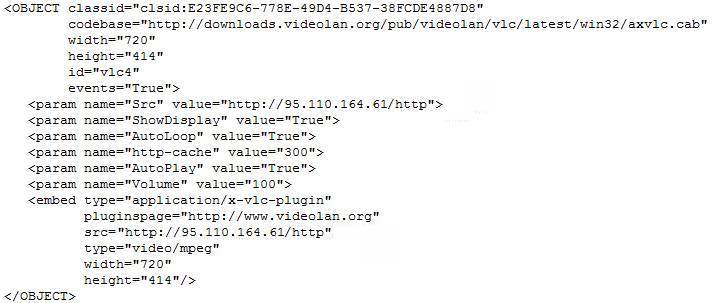Italian
Perche'
Cosa hanno di particolare questi stream e cosa serve per vederli
Prove di streaming da cloud
Al momento sto erogando diversi stream dallo stesso cloud server che eroga questo sito web: puoi trovare la lista completa (e speriamo aggiornata) in questa pagina.
English
Why
What are these streams and what is required to view them
Streaming experiments from cloud
At the moment I'm streaming many streams from the same cloud server which erogates also this website: you can find the complete (and hopefully updated) list in this page.
Note al primo video utilizzato
Il primo video che ho utilizzato in definizione ordinaria (e il piu' importante dal punto di vista politico) e' la collezione di cinque cortometraggi prodotti dal gruppo "the story of stuff project" doppiati in italiano (grazie, Alice di Palermo!) perche' penso che sia molto importante che il loro messaggio sia conosciuto anche in italiano. Sul sito originale puoi trovare l'intera produzione in inglese. Sul web sono comunque reperibili in molte altre lingue. Basta cercare.
I filmati originali sono accessibili su youtube:
la storia delle cose
la storia dell'acqua in bottiglia
la storia dei cosmetici
la storia dell'elettronica di consumo
la storia del cap and trade (il commercio dei diritti ad inquinare)
Standard Definition video disclaimer
The first video in standard definition I've used (and the most important from the political point of view) is a collection of five shorts produced by "the story of stuff project" overvoiced in italian, because I think it is extremely important to spread its message in mine as well in all languages. You can find a plenty of translations: it is sufficient to browse the web.
The original movies can be found on the story of stuff channel of YouTube:
The Story of Stuff
The story of bottled water
The story of consumer electronics
The story of cosmetics
The story of cap & trade (The business of polluting rights)
Carico computazionale
Queste pagine richiamano dei transport stream MPEG-2 (DVB) contenenti elementary stream h264 o mpeg2 con audio aac o mp3 (mpeg1 layer 3).
La riproduzione potrebbe non risultare fluida, specie per i video in h264 a bitrate maggiore di 1 Mbps, a volte non disponibili se sei in WiFi o UMTS.
Confronta queste tre immagini, tutte prese da un netpc basato su Intel Atom con 2 GB di Ram durante la decompressione di sequenze in standard definition
o CIF in MPEG2 ed h264:
Computational Load
These pages recall DVB MPEG-2 Transport stream containing h264 or mpeg2 elementary streams with aac or mp3 (mpeg1 layer3) audio.
The reproduction could not be fluid, expecially for h264 at bitrate higher than 1 Mbps, that could not be available if you're connected in wi-fi or UMTS.
Compare these three images, all them taken from a netpc built upon an Intel Atom with 2 GB di Ram during the decompression of
standard definition (PAL) or SIF sequences in MPEG2 or h264:
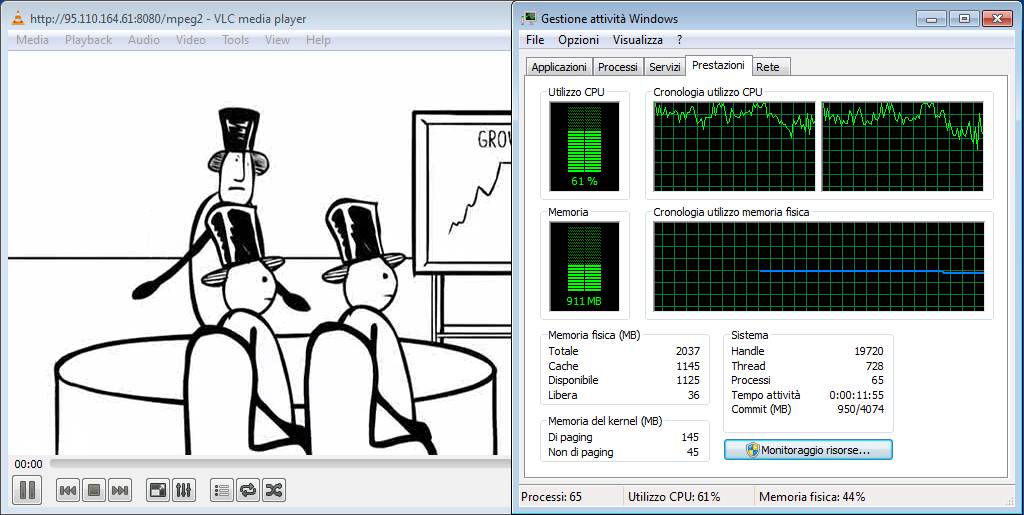
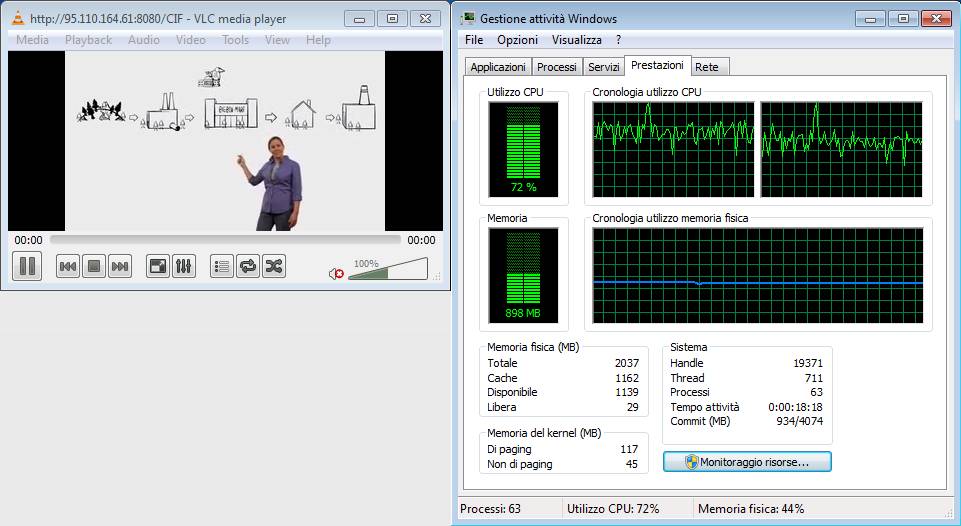
Riproduzione del flusso h264 SIF 16:9 (index2a)
Malgrado i fotogrammi da decomprimere siano grandi meno di 1/4, la potenza di calcolo impegnata e' maggiore dell'mpeg2
Reproduction of h264 SIF 16:9 stream (index2a)
Despite the frames are less than 1/4 of the former, the required power to decode h264 is greater than mpeg2
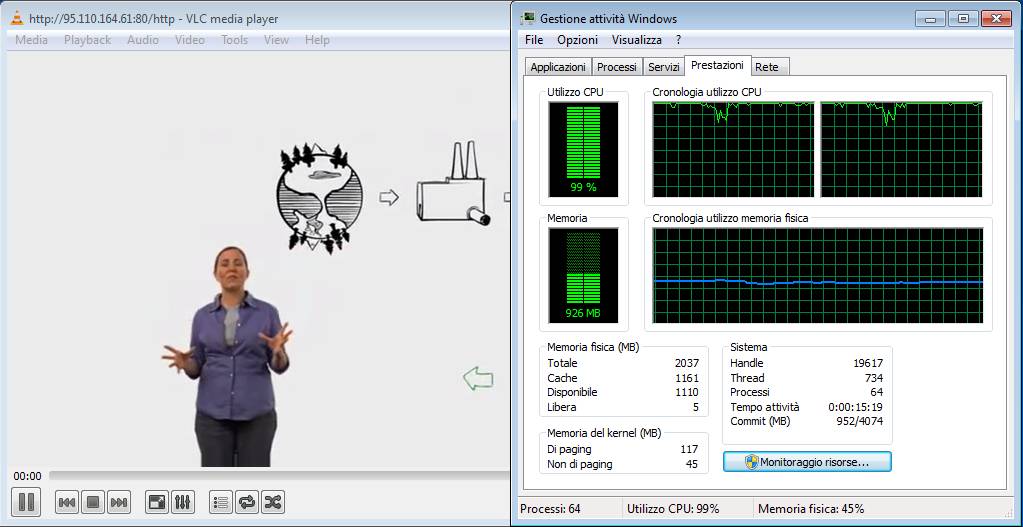
Riproduzione non corretta del flusso h264 PAL (index3a) per insufficiente potenza di calcolo.
Per valutare la qualita' di riproduzione si deve considerare che la complessita' della decodifica dell'h264 e' tre-cinque volte maggiore dell'MPEG2, e anche che in una immagine HD (1280x720 o 1920x1080) debbono essere generati circa 3 o 6 volte piu' pixel di una ordinaria immagine PAL (720x576).
In caso di carico elevato il server potrebbe non rispondere correttamente a tutte le richieste di replica TCP da parte dei client. In ogni caso (a tempo infinito) lo stream dovrebbe essere ricevuto in modo perfetto.
Per ragioni di rete
Sono stream http (quindi tcp/ip), tutto fuorche' ideali per lo streaming del video, ma i cui pacchetti riescono a passano (quasi) tutte le barriere. Problemi potrebbero essere dati dall'irregolare flusso delle informazioni, non correttamente recapitate al player in tempo utile per essere decodificate e presentate al momento giusto. Questo puo' essere valutato dal Media Delivery Index, introdotto nel 2006 con la RFC 4445 da Welch (Ineoquest) e Clark (Cisco). La spiegazione e' reperibile nella voce di Wikipedia (in inglese) ma pefettamente illustrato dal seguente grafico estratto dal documento della Ineoquest Media Delivery Index Application Note.
Uncorrect Reproduction of h264 PAL stream (index3a) for unsufficient computing power
To evaluate the reproduction quality it must not be forgotten that the decoding complexity of h264 is three-five time more heavy than MPEG2, and also that in a HD (1280x720 or 1920x1080) there are from 3 to 6 time more pixel to generate than an ordinary PAL image (720x576).
In case of high drain, the server could be unable to handle properly all the TCP reply requests. In any case (at infinite time) the reception of the stream should be perfect.For network reason
They are http streams (so tcp/ip), all but the ideal video streaming method but their packets can pass through (about) all the possible barriers. Problem may arise from the the uneven flow of information, not correctly delivered to the player in time to be decoded and presented at the right time. This can be evaluated by Media Delivery Index, introduced in 2006 with RFC 4445 by Welch (Ineoquest) and Clark (Cisco). It is explained in the Wikipedia's lemma but perfectly shown by the following graphic taken from Ineoquest's document Media Delivery Index Application Note.
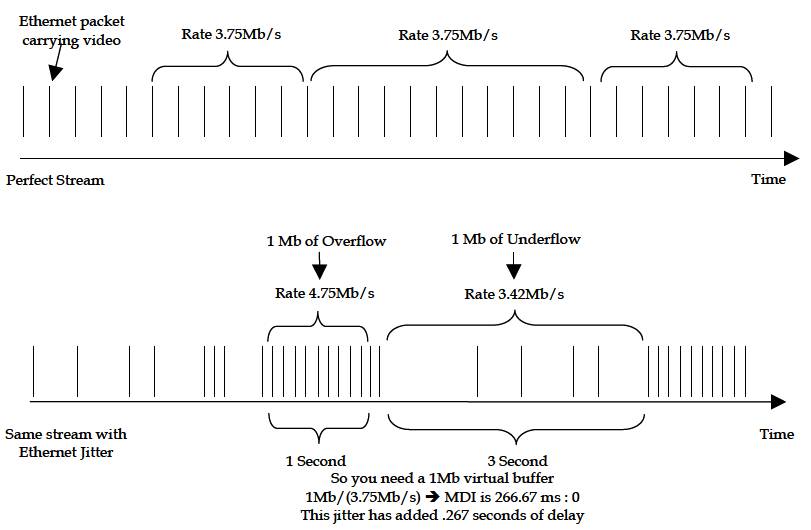
Mostra - a mio avviso molto chiaramente - perche' un player non e' in grado di riprodurre correttamente un flusso di 3,75 Mbps
pur avendo probabilmente ricevuto tutti i bit necessari: tutti ma non al momento giusto.
Ma il TCP assicura comunque la corretta distribuzione dei pacchetti.
It clearly represents why a player may be unable to show correctly a flow of 3,75 Mbps despite it get all the required bits:
all but not at the right time
In this case, moreover, you may rely that TCP insure to deliver all the packets. And you can believe that this is true.
Note
Altre informazioni tecniche (compresi problemi affrontati e superati) possono essere trovate in questa pagina (only in english).
Proxed (traducibile in "mediati" ma piu' correttamente "inversamente mediati", dall'inglese "reverse proxy") significa che il
flusso originale erogato da VLC viene mediato da Apache sulla porta indicata nel suo file di configurazione.
Anche il flusso originale potra' essere riprodotto da un player esterno se le caratteristiche del
collegamento lo permettono: se ad esempio il firewall del server o quello del tuo router ADSL blocca la/le porte di
erogazione, il flusso non sara' riproducibile
Anche se il protocollo usato e' sempre http, un browser non riuscira' ad aprire questi stream nativi: se ci provi, ti sara' proposto di
salvarlo, e/o di aprirlo con una applicazione predefinita o da scegliere. Essendo uno stream virtualmente infinito, sara' effettuato
un dump parziale, vale a dire ne sara' salvata una porzione sull'hard disc. Questa potra' essere aperta da VLC solo avendolo salvato con estensione
.ts (o .mpg).
Il file httpd.conf di Apache e' case sensitive: cif e' diverso da CIF, anche se in Internet sono identici!
Se usi Firefox, Safari, Chrome o Opera12, per la corretta visualizzazione di queste pagine e' necessario il plug-in di VLC
ed inoltre sono richiesti dei corretti settaggi dei mime type.
Se usi Internet Explorer, in base al livello di sicurezza impostato, ti potra' venire richiesta l'autorizzazione di caricare il plug-in direct-x
di vlc specificato nella pagina html.
Questa sotto e' la chiamata tipica e' scritta in modo compatibile per Internet Explorer e per Firefox/Chrome/Safari:
Notes
Other technical informations (including the trouble found and shooted) can be found in this page.
Reverse Proxed means that the original stream generated by VLC is mediated by Apache on the port(s) specified in the configuration file.
The original stream could also be accessed by an outside player if the connection characteristics allow it: if e.g. any firewall (the server or that embedded in your
ADSL router) stops the required port(s), the stream will be unviewable
Native stream, despite erogated in plain http, cannot be opened by a browser: if you try, you will required to save them
and /or open with an application predefined or to be chosen. Being a virtually endless stream, this will produce a partial dump,
i.e. only a portion will be saved on the specified path. That file might be opened only if a mime extension has been specified:
VLC will open it only if named as .ts or .mpg.
The Apache configuration file httpd.conf is case sensitive: cif is different from CIF despite they are identcal over the Internet!
If you use Firefox, Safari, Chrome o Opera12 the correct visualization requires VLC Mozilla plug-in and is possible only
in presence of correct mime type settings.
If you use Internet Explorer, depending on the safety issues set in preferences, you will be prompted for a grant to load the plug-in direct-x di vlc specified in the html page
The following is the typical Internet Explorer and Firefox/Chrome/Safari compatible call :
